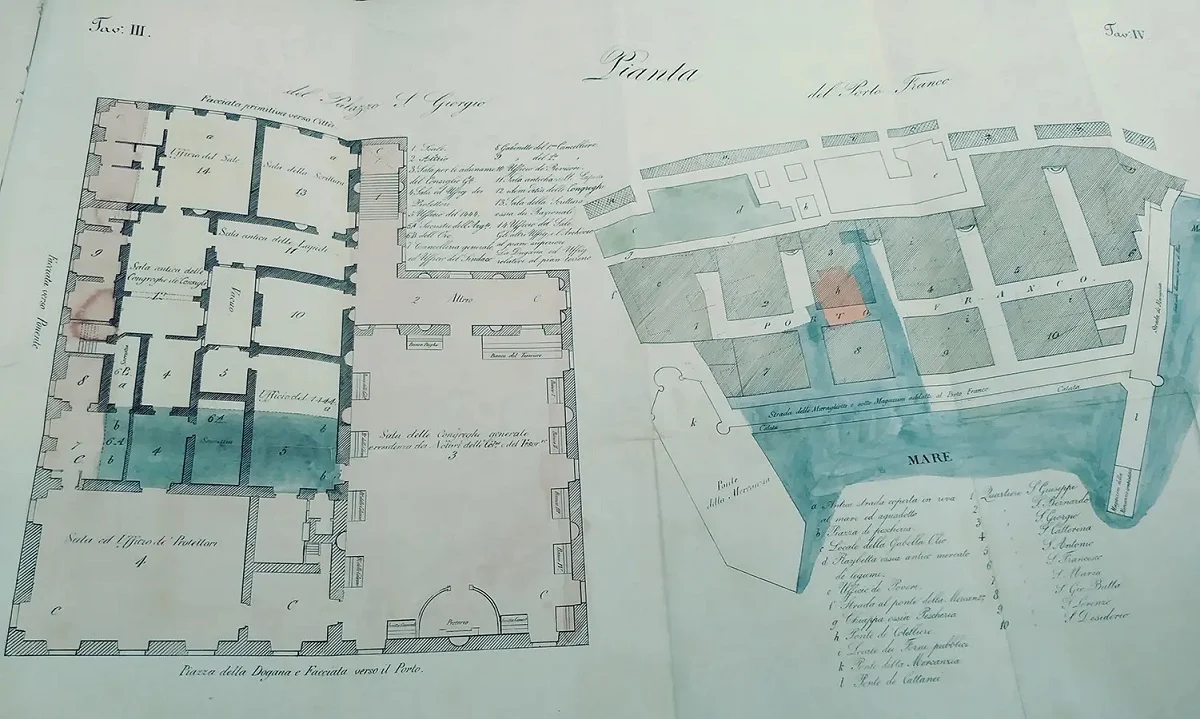
History
The palace in the history of Genoa
At the end of the 13th century, there was no building in Genoa that stood as a symbol of the political power that was exercised both in the Archbishop's Palace and in private palaces. In the mid-13th century, Guglielmo Boccanegra, Captain of the People from 1256 to 1262, decided to begin the construction of a public palace at the very heart of the commercial and trade hub, that is, on the sea, in front of the port. The design and construction of the building was entrusted to Benedictine friar Oliverio, who had directed the works for the construction of the ancient dock – the Molo Vecchio – a few years earlier.
The new building was constructed on the area created by covering the mouth of the Suziglia stream, in a privileged position with respect to the line marked by the Ripa Maris, the area of the city where trades related to commerce and navigation were carried out. When Guglielmo Boccanegra was ousted from power in 1262, it is unclear whether the palace had been fully completed or if the construction was still underway.
However, we know from a notarial deed of 1278 that the palace was named palatium magnum maris fundatum sub basilica sancti Petri, ubi nunc colliguntur introitus, i.e. not subject to taxation.
In 1340, the "palace of the sea" became the Customs office that was mainly linked to the activities of the port. At that time, we know that the courtyard was used as a storage area for goods subject to duties, while on the first floor were the offices of the Calleghe (Disputes over the application of duties), the Gazaria (Administration of the Colonies) and the Confortatori (Exemption from taxes and duties). It is also said – though there is no proof of this – that the top floor was reserved for prisons for tax evaders.
In the 15th century, the Palace was chosen to house the Bank of Saint George or Casa delle Compere, an institution founded in 1407 by the French governor Jean Le Meingre to absorb the public debt. Within a short period of time, the Bank of Saint George consolidated its power up to the point of managing the public economy and taking control of the colonies.
Also in the 15th century, the palace was equipped with two bridges over the sea, which were later named the Ponte della Mercanzia and the Ponte Reale. The sources also state that in 1508 a Porticus Duganae was built against the western side of the Palace by filling in the water area in front.
In 1451, the assignment of the headquarters to the Bank of Saint George became final. In 1539, Andrea Doria unified all the purchases under the administration of the Bank, gradually creating different forms of bank credit, financing public works and taking over the mint, which was in the vicinity of the building for a long time.
In 1571, responding to the needs posed by the new functions of the Bank, the building underwent radical expansion and renovation work that completely changed its appearance, incorporating the old structure into the new one. During those years, a façade decorated in the Renaissance style was created, symbolising the power of the institution. It was initially adorned by Andrea Semino and later by Lazzaro Tavarone (1606-1608).
The medieval layout and structures were brought to light by D'Andrade's intervention at the end of the 19th century, when the Palace was completely restored after years of neglect due to Napoleon's domination, which marked the end of the Bank of Saint George and led to the Palace being used first as a warehouse and then as a prison.
The restoration began after a long debate. The growth in traffic posed the need to build modern and adequate roads. At the same time, it was necessary to create a new directorate for port activities and find a suitable location to host it. Palazzo San Giorgio was an obstacle to the construction of a new road system, but at the same time, it could become the appropriate location to host the new institution. In the end, the argument in favour of conservation and restoration, which began in 1890 and was directed by architect Alfredo D'Andrade, prevailed.
After the restoration conducted by D'Andrade, Palazzo San Giorgio became the setting for some of the most important events of the last century. In 1904, it became the headquarters of the Autonomous Port Consortium, the economic and technical body governing the port established in 1903.
In 1922, it hosted one of the days of the International Conference of Genoa, bringing the ministers of the countries that had taken part in the First World War to the Palace.
During the Second World War, Palazzo San Giorgio was bombed, and the Renaissance part of the building was seriously damaged, both in terms of structures and works.
After the war, it was completely restored as we see it today. The most recent restoration of the façade paintings was carried out in 1992 by the painter Raimondo Sirotti on the occasion of the Columbus Celebrations.
From 1995 to 2016, it hosted the headquarters of the Port Authority of Genoa, a public body into which the Autonomous Port Consortium was transformed in 1994.
Today, it is the headquarters of the Western Ligurian Sea Port Authority.





